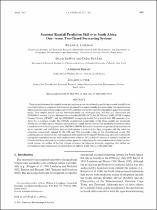 ResearchSpace
ResearchSpace
Seasonal rainfall prediction skill over South Africa: one- versus two-tiered forecasting systems
JavaScript is disabled for your browser. Some features of this site may not work without it.
- ResearchSpace
- →
- Research Publications/Outputs
- →
- Journal Articles
- →
- View Item
| dc.contributor.author |
Landman, WA

|
|
| dc.contributor.author |
Dewitt, D

|
|
| dc.contributor.author |
Lee, D-E

|
|
| dc.contributor.author |
Beraki, Asmerom F

|
|
| dc.contributor.author |
Lotter, D

|
|
| dc.date.accessioned | 2012-10-02T11:47:49Z | |
| dc.date.available | 2012-10-02T11:47:49Z | |
| dc.date.issued | 2012-04 | |
| dc.identifier.citation | Landman, WA, Dewitt, D, Lee, D-E, Beraki, A.F. and Lotter, D. 2012. Seasonal rainfall prediction skill over South Africa: one- versus two-tiered forecasting systems. Weather and Forecasting, vol. 27(2), pp 489-501 | en_US |
| dc.identifier.issn | 0882-8156 | |
| dc.identifier.uri | http://journals.ametsoc.org/doi/pdf/10.1175/WAF-D-11-00078.1 | |
| dc.identifier.uri | http://journals.ametsoc.org/doi/abs/10.1175/WAF-D-11-00078.1?journalCode=wefo | |
| dc.identifier.uri | http://hdl.handle.net/10204/6122 | |
| dc.description | Copyright: 2012 American Meteorological Society | en_US |
| dc.description.abstract | Forecast performance by coupled ocean–atmosphere or one-tiered models predicting seasonal rainfall totals over South Africa is compared with forecasts produced by computationally less demanding two-tiered systems where prescribed sea surface temperature (SST) anomalies are used to force the atmospheric general circulation model. Two coupled models and one two-tiered model are considered here, and they are, respectively, the ECHAM4.5–version 3 of the Mesoscale Ocean Model (MOM3-DC2), the ECHAM4.5-GML– NCEP Coupled Forecast System (CFSSST), and the ECHAM4.5 atmospheric model that is forced with SST anomalies predicted by a statistical model. The 850-hPa geopotential height fields of the three models are statistically downscaled to South African Weather Service district rainfall data by retroactively predicting 3-month seasonal rainfall totals over the 14-yr period from 1995/96 to 2008/09. Retroactive forecasts are produced for lead times of up to 4 months, and probabilistic forecast performance is evaluated for three categories with the outer two categories, respectively, defined by the 25th and 75th percentile values of the climatological record. The resulting forecast skill levels are also compared with skill levels obtained by downscaling forecasts produced by forcing the atmospheric model with simultaneously observed SST in order to produce a reference forecast set. Downscaled forecasts from the coupled systems generally outperform the downscaled forecasts from the two-tiered system, but neither of the two systems outscores the reference forecasts, suggesting that further improvement in operational seasonal rainfall forecast skill for South Africa is still achievable. | en_US |
| dc.language.iso | en | en_US |
| dc.publisher | American Meteorological Society | en_US |
| dc.relation.ispartofseries | Workflow;8591 | |
| dc.subject | Seasonal forecasting | en_US |
| dc.subject | Coupled models | en_US |
| dc.subject | Statistical downscaling | en_US |
| dc.subject | South African rainfall prediction | en_US |
| dc.subject | Forecasting systems | en_US |
| dc.title | Seasonal rainfall prediction skill over South Africa: one- versus two-tiered forecasting systems | en_US |
| dc.type | Article | en_US |
| dc.identifier.apacitation | Landman, W., Dewitt, D., Lee, D., Beraki, A. F., & Lotter, D. (2012). Seasonal rainfall prediction skill over South Africa: one- versus two-tiered forecasting systems. http://hdl.handle.net/10204/6122 | en_ZA |
| dc.identifier.chicagocitation | Landman, WA, D Dewitt, D-E Lee, Asmerom F Beraki, and D Lotter "Seasonal rainfall prediction skill over South Africa: one- versus two-tiered forecasting systems." (2012) http://hdl.handle.net/10204/6122 | en_ZA |
| dc.identifier.vancouvercitation | Landman W, Dewitt D, Lee D, Beraki AF, Lotter D. Seasonal rainfall prediction skill over South Africa: one- versus two-tiered forecasting systems. 2012; http://hdl.handle.net/10204/6122. | en_ZA |
| dc.identifier.ris | TY - Article AU - Landman, WA AU - Dewitt, D AU - Lee, D-E AU - Beraki, Asmerom F AU - Lotter, D AB - Forecast performance by coupled ocean–atmosphere or one-tiered models predicting seasonal rainfall totals over South Africa is compared with forecasts produced by computationally less demanding two-tiered systems where prescribed sea surface temperature (SST) anomalies are used to force the atmospheric general circulation model. Two coupled models and one two-tiered model are considered here, and they are, respectively, the ECHAM4.5–version 3 of the Mesoscale Ocean Model (MOM3-DC2), the ECHAM4.5-GML– NCEP Coupled Forecast System (CFSSST), and the ECHAM4.5 atmospheric model that is forced with SST anomalies predicted by a statistical model. The 850-hPa geopotential height fields of the three models are statistically downscaled to South African Weather Service district rainfall data by retroactively predicting 3-month seasonal rainfall totals over the 14-yr period from 1995/96 to 2008/09. Retroactive forecasts are produced for lead times of up to 4 months, and probabilistic forecast performance is evaluated for three categories with the outer two categories, respectively, defined by the 25th and 75th percentile values of the climatological record. The resulting forecast skill levels are also compared with skill levels obtained by downscaling forecasts produced by forcing the atmospheric model with simultaneously observed SST in order to produce a reference forecast set. Downscaled forecasts from the coupled systems generally outperform the downscaled forecasts from the two-tiered system, but neither of the two systems outscores the reference forecasts, suggesting that further improvement in operational seasonal rainfall forecast skill for South Africa is still achievable. DA - 2012-04 DB - ResearchSpace DP - CSIR KW - Seasonal forecasting KW - Coupled models KW - Statistical downscaling KW - South African rainfall prediction KW - Forecasting systems LK - https://researchspace.csir.co.za PY - 2012 SM - 0882-8156 T1 - Seasonal rainfall prediction skill over South Africa: one- versus two-tiered forecasting systems TI - Seasonal rainfall prediction skill over South Africa: one- versus two-tiered forecasting systems UR - http://hdl.handle.net/10204/6122 ER - | en_ZA |





